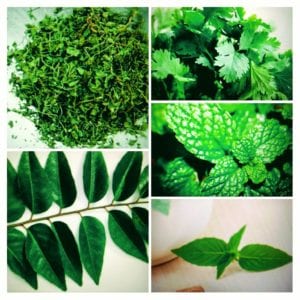May 15, 2017
Herbs
When people talk about a healthy diet, they aways talk about fresh fruits, vegetables and whole grains. Herbs are not often talked about or included in new diets. However, they have loads of vitamins and minerals in them that not many people know about! By adding as little as 5 to 10 leaves per day, it could bring a great change to your immune system. There are many Herbs that could be talked about, but today I would like to share some benefits about five Herbs that I have been using in my day to day cooking for many years. These Herbs have been a part of cooking in my family for many generations, some of which you might have already heard of, and some of which might be new.
Coriander
Coriander or Cilantro in North America is a herb that is extensively used around the world as a condiment, garnish, or decoration on culinary dishes. I grew up with this herb as it would be included in everyday cooking. No dish is complete without garnishing it with coriander leaves! It has a very distinctive aroma and I love the texture and color it adds to the dish.
Coriander is not only aroma and taste, it has many health benefits. It is rich in Phytonutrients and flavonoids, both of which are associated with antioxidant benefits. Multiple studies have shown Coriander to have strong anti-histamine properties that can reduce the uncomfortable affects of seasonal allergies and hay fever(rhinitis). Internally, it can ward off anaphylaxis, hives, dangerous swelling of the throat and glands, and It also aids in digestion. It also acts as an anti-septic to cure mouth ulcers. It is a good source of dietary fiber, iron, magnesium, and vitamin K.
Curry Leaves
Curry Leaves are commonly used as food garnish originating from southern India. This herb helps improve digestion. It is also packed with antioxidants such as Vitamin A, C and E, and minerals such as calcium, phosphorous, iron, Magnesium and Copper. It also contains various other vitamins such as: nicotinic acid and vitamin B, plant sterols, amino acids, and flavonoids.
In Ayurveda it is believed to help in preventing cataract. This herb used in the right quantity can also aid in weight loss as well as prevent diabetes. It can also be used as a natural cleanser as it flushes out bad toxins. You can make a Curry Leaf mask by preparing boiling curry leaves and combining them with yogurt which will result in a smooth paste that you can apply as a hair mask. It will help bring a natural shine to your hair and also strengthen it.
Mint
Mint is most commonly known for its cooling effect in the month to freshen breath. There are many types of mint, but in this case, I am specifically talking about Spearmint. Interestingly, it has many more health benefits than Peppermint. It activates salivary glands which helps in getting the digestive juices flowing in the stomach. It soothes stomach inflammation and slows down the growth of harmful bacteria inside your mouth. It has many vitamins and minerals such as Vitamin A and C, Riboflavin, Folate, Calcium, Iron, Magnesium, Potassium, Copper and Manganese. Mint is also a good source of Thiamine, Niacin, Vitamin B6, Phosphorous and Zinc.
Basil (Tulsi)
Eating 3-4 fresh Basil leaves everyday in the morning can make your immune system healthy and strong as it is a good source of Vitamin A and C. In India, Basil has a special place in the kitchen as it has many health benefits and medicinal values in it. A lot of research has shown that eating Basil can reduce fevers, pain, prevent diabetes, protect the liver, and reduce stress levels. It is an excellent source of manganese and Vitamin K. It also contains other minerals such as Calcium, Iron, folate and Magnesium.
Dried Fenugreek Leaves (Kasuri Methi)
Fenugreek leaves and Fenugreek seeds can both be used in cooking. Today I would like to share the benefits of dried Fenugreek leaves. If stored in an airtight container away from moisture, these leaves can last a lifetime. They can be added as a garnish in soups and salads to help maintain blood sugar levels. These leaves have minerals such as: Calcium, Zinc, Potassium, Phosphorous, Iron, Selenium, Magnesium and Copper; Vitamins such as: Thiamin, Riboflavin, Folic acid, Niacin, Vitamin A, C and B6. They have similar benefits to cinnamon as they help control glucose levels and metabolism. Eating these leaves may help prevent type II diabetes and may also help in reducing LDL levels (bad cholesterol levels).
These are some of the herbs that I use for their amazing health benefits. I use Coriander and Curry leaves almost every day, and dried Fenugreek and Mint leaves occasionally. They bring out not only flavors and colours to dishes that I make, but they also add vitamins and minerals. As herbs have their own benefits, it’s always wise to use them in small quantities and gradually introduce them into your diet if you haven’t used them before. Toxicity or allergic reactions to these Herbs are rare but should not be forgotten. So before using a new Herb, it’s always good to gather more information just to be safe!

References
www.nutritiondata.self.com


